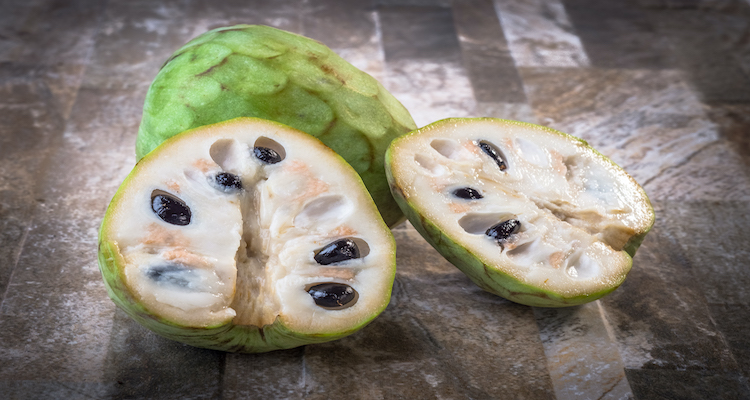
Cherimoya (Annona cherimola) is a decadent South American fruit known for its appearance, taste, and texture. Its armor-like skin, much like an artichoke, protects a cream custard-like, edible flesh.
The sweet flavor and creamy texture have even earned Cherimoya the nickname “apple custard.”
But junk food this is not.
Cherimoya is packed with nutrients that can work towards a number of health benefits. It may help improve immune strength, fight inflammation, and promote eye and heart health.
So, grab a spoon and start eating! Just be careful…more on that later.
Cherimoya Nutrition Facts
Cherimoya is rich in fiber, vitamins, and minerals. It’s also a great source of diverse antioxidants to help preserve cell health and fight inflammation caused by free radicals.
One seedless, skinless cherimoya contains:
| Nutrient | Amount | % Daily Value |
| Calories | 231 | 12% |
| Carbohydrate | 55 g | 18% |
| Fiber | 7 g | 29% |
| Fat | 2 g | 3% |
| Protein | 5 | 10% |
| Vitamin C | 36 mg | 60% |
| Thiamin | 0.3 mg | 19% |
| Riboflavin | 0.4 mg | 22% |
| Niacin | 1.8 mg | 9% |
| Vitamin B6 | 0.7 mg | 33% |
| Folate | 56.2 mcg | 14% |
| Vitamin B12 | 0 | 0% |
| Pantothenic Acid | 0.7 mg | 7% |
| Magnesium | 49.9 mg | 12% |
| Iron | 0.9 mg | 5% |
| Phosphorus | 81.1 mg | 8% |
| Potassium | 839 mg | 24% |
| Copper | 0.2 mg | 11% |
| Manganese | 0.3 mg | 13% |
| Zinc | 0.6 mg | 4% |
Potential Health Benefits of Cherimoya
There a number of ways that cherimoya benefits health. It is not a magical fruit, however. It simply features nutrients that are known to optimize functionality in organs, the immune system, and more. When included in a healthy diet, cherimoya may help:
Promote Healthy Blood Pressure
Cherimoya is a good source of potassium and magnesium, two nutrients that play an important role in blood pressure.
Magnesium and potassium help dilate blood vessels so blood pumps through them more easily. This helps reduce blood pressure.
Potassium also plays a role in heart muscle contractions and managing sodium levels.
Strengthen the Immune System
Cherimoya is a great source of vitamin C that can offer support to your immune system. Getting enough vitamin C every day can help your body fight off infections and potentially reduce the duration and symptom strength of illnesses.
There are also a variety of flavonoids (antioxidant plant compounds) that can help boost immune function.
Some of these compounds, like catechin, epicatechin, and epigallocatechin, may have anti-cancer effects.
Fight Inflammation
There are numerous compounds in cherimoya that may help fight chronic inflammation that can contribute to dangerous illnesses like heart disease.
Anti-inflammatory compounds in cherimoya include:
- Kaurenoic acid
- Catechin
- Epicatechin
Reduce the Risk of Vision Loss
Cherimoya is rich in lutein, a carotenoid that is one of the main antioxidants in your eyes.
A number of studies show that lutein intake is associated with a lower risk for age-related macular degeneration (AMD), one of the leading causes of vision loss in older people.
Lutein may also help protect against cataracts.
Reduce the Risk of Depression
Vitamin B6 deficiency is closely associated with depression. One piece of cherimoya provides more than 30% of the daily recommended intake for vitamin B6.
Studies have shown that the risk of depression doubles in older adults who are deficient in B6.
Improve Digestion
If you’re looking for a big hit of fiber, cherimoya’s got you covered. Not only does one fruit offer a whopping seven grams, but it can also feed the healthy bacteria living in your gut.
How to Prepare Cherimoya
Buying cherimoya is much like buying avocado and similar fruits. It is ripe and ready to eat when it is heavy, dark green, and a bit soft when you apply pressure. If you get one that is too firm and not quite ripe, let it sit at room temperature until it’s ready.
You can eat it easily with a spoon by cutting it half, removing the seeds, and scooping out the flesh. It can also be peeled and cut into cubes; just remember to remove the seeds.
Removing the seeds and not eating the skin are very important steps.
Other ways to eat cherimoya include:
- Blended in a smoothie
- Frozen and pureed for a homemade sorbet
- Sprinkled on a salad
- As a pie filling
- Chopped up in a salsa with jalapeno peppers
Cherimoya Risks
It’s imperative to only eat the flesh of cherimoya and discard the skin and seeds. The seeds and skin feature a toxic compound called annonacin that can affect the brain and nervous system.
Cherimoya is part of the Annona family, and every member features the toxin.
There is research to suggest that high consumption levels of Annona fruits increases the risk of a specific form of Parkinson’s disease.
If you’re concerned about Parkinson’s or the toxins in cherimoya, don’t eat it! Otherwise, as long as you get rid of the seeds and skin, you should be okay.
Sources:
Brennan, D., “Health Benefits of Cherimoya,” WebMD, September 2, 2020; https://www.webmd.com/diet/health-benefits-cherimoya#1, last accessed December 3, 2020.
Streit, L., “8 Surprising Benefits of Cherimoya (Custard Apple),” Healthline, April 10, 2019; https://www.healthline.com/nutrition/cherimoya, last accessed December 3, 2020.
“Cherimoya, raw nutrition facts & calories,” SELFNutrition Data, 2020; https://nutritiondata.self.com/facts/fruits-and-fruit-juices/1860/2, last accessed December 3, 2020.













